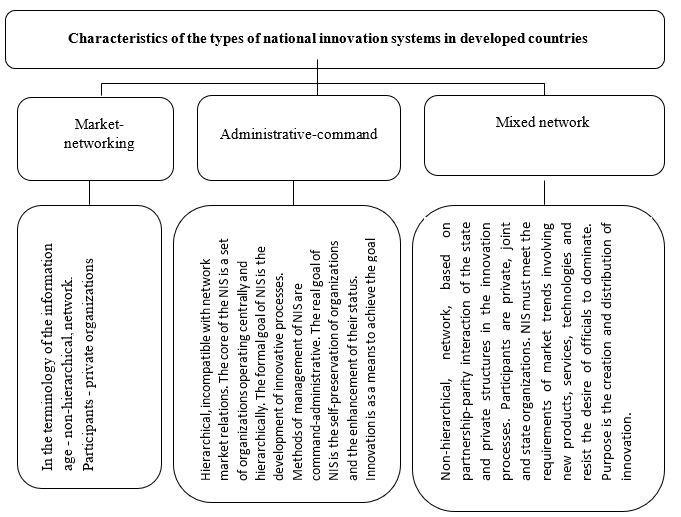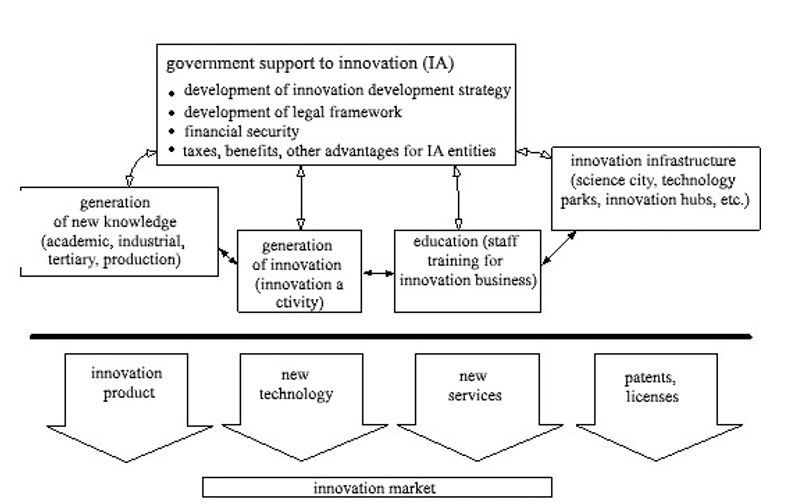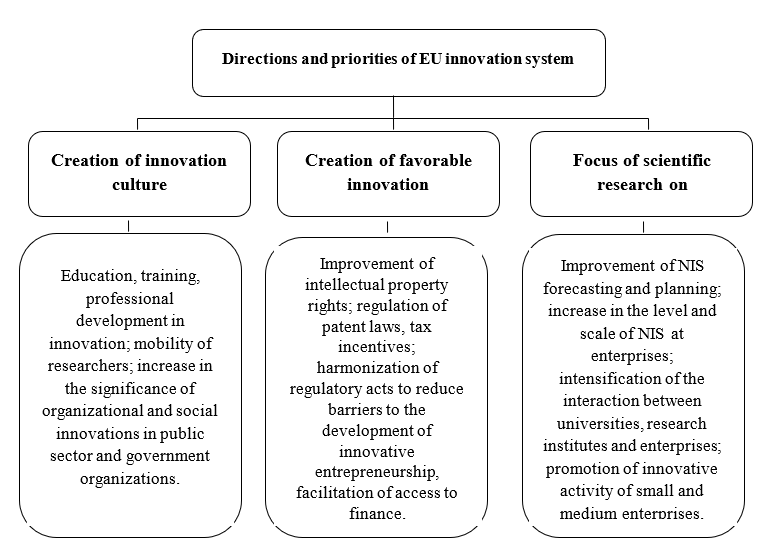Abstract
The authors believe that innovation activity (IA) in modern Russia has been provided at a fairly good level by scientific personnel accumulated in high school and postgraduate science over the last 10–15 years. Despite the lack of resources, it has managed to maintain leading positions in the high-tech industries including oil production, oil and produced gas processing, energy, space technology, military technology and others. In Russia there was no clear mechanism for bringing the results of scientific research to a commercial level, i.e. to the implementation stage. For this and some other reasons, the share of innovative products in the total volume of products is small. About 6% of enterprises are actively participating in the innovation process, while in the United States the number of enterprises makes up about 30%. In the context of the emerging global economy, the standard of living of the population, investment attractiveness and the place of the state in the modern world are determined by the degree of innovation development of the national economy. The article explores the experience of the formation of innovation systems that have emerged in various countries around the world. The main models of national innovation systems that are most widely used in the world, their main distinctive features are highlighted.
Keywords: National innovation systemmodels of national innovation systemsinnovation processscientific and technical progress
Introduction
The relevance of study is attributed to the importance for the modern economy to shift towards an innovative path of development. Today, the gross domestic product of economically developed countries is formed through innovation. It is the embodiment of new scientific and practical ideas, approaches, initiatives that today largely determine the quality of socio-economic development of countries. All over the world, and in Russia in particular, among the most priority areas of innovation development are: information technology, ecology, living matter, alternative, energy-saving technologies, artificial intelligence, nanotechnology, recycling of household and industrial waste. As part of the interdepartmental program for the intensification of innovation activities in Russia, 36 innovation technology centers and 70 technology parks have been established that feature at least 300 small innovation enterprises (Bystrova, 2010). In the wake of globalization, the world economy is being transformed into a single resource market, in which the position of each country is determined by the level of development of its science, education, information technology, health, environment, knowledge-intensive industries and technologies, the ability of the country and regions to boost innovation activities of enterprises and companies, especially those in the agro-industrial complex. The world practice has vividly proved that the intellectual potential of the country's population plays the key role in its development. The economists estimate that 70%-95% of the GDP increment is accounted for by innovative factors. Special emphasis should be placed on national innovation systems and their subsystems, with education and science being the priorities along with the replacement of hierarchical structures by behavioral ones that are individually adapted to the needs of their consumers. These are the systems established with the focus on industries, areas and sectors with accumulated technological pools, often by sequestering secondary spheres of the economy.
Problem Statement
Modern theorists and practitioners are currently addressing the development of innovation systems in modern economies. The versatile character of innovation activity has allowed the development of various theoretical and methodological approaches to the definition of innovation. As confirmed by many examples, copying someone else’s experience, even the most positive and effective, will not necessarily be positive when being adjusted for Russian realities. The success will require “local” approbation, taking into account the specifics, perception of changes, confidence of business in regional authorities, etc.
Research Questions
The study presents an overview of the world experience gained in those countries where national innovation systems play a crucial role in economic development. The most effective methodology to intensify innovation activity is the use of public-private partnership mechanisms, as evidenced by the experience of the United States, Japan and Western Europe (Gorodnova & Skipin 2010). The structure of the global innovation market indicates that science-intensive products are produced by 50 macro-technologies, while the United States controls the lion's share of the innovation market (about 20-22 positions), Germany (8-10), Japan (7), the United Kingdom and France ( 3-5 positions each). Many experts consider the rapid growth in the variety of goods and the increase in per capita gross domestic product as the achievements of leading countries over the recent time (Lavrov, 2009).
Purpose of the Study
The purpose of study is the justification of innovation activity to conduct comparative assessments of the development of innovation activity in the EU countries, with the aim of integrating the national innovation system (NIS) of the Russian Federation into the global innovation system.
Research Methods
The methodology contains a systematic approach related to the study of the main attributes determining the development of NIS in the modern economy. The following research methods were used, namely: comparative analysis, generalizations and typologies.
Findings
In each country the innovation system is distinguished by individual features, but there are also general characteristics. One of them implies the mandatory participation of the state.
Analyzing the evolution of NIS in developed countries and the domestic experience of managing scientific and technical potential, we should highlight 3 types of national innovation systems (Figure

A clear correlation can be observed. As soon as the state weakens its coordinating and regulating activity, conflicts arise between science and business, but the effectiveness of state participation is ensured by the partner rather than the dominant form.
In Russia, the NIS is at the stage of formation. Being aware of the complexity of the tasks set, it would be advisable to address foreign experience, but with an insight into the specifics of domestic regions (Figure

Due to the fact that governments, using NIS mechanisms, solve various problems of the development, the applied innovation systems are all different, especially in terms of goals and objectives.
With a view to adopting the experience of developed countries in the Russian Federation, innovative development in several foreign countries will be considered.
The root causes of innovation failures in the EU countries were identified in the report Green Paper on Innovation (1995) – this is archaism, routine, bureaucracy, “... the idea, even the most fruitful, mostly perishes. At best, a good idea is hampered ...”, which, long before that, was defined by K. E. Tsiolkovsky as inertia, conservatism, stagnation, distrust of everything new, egoism of the ruling class, unwillingness to retrain (Borko, Butorina, Zhurkina, & Potemkina, 2010).
The first action plan elaborated to foster the development of innovation in the European countries outlined 3 directions (Figure

The formation of IA in Europe was quite long and extremely difficult, since all the 28 states in the EU are completely different in terms of innovation activity and potential (Kiseleva & Phonotov, 2013; HSE, 2013).
Across
all socio-economic and environmental endeavors aimed at the development of territories based on innovations, aspects of innovation policy, actions of authorities, the media and the public should be streamlined along a single trajectory;
medium and small enterprises are most effective and preferred in terms of increase in the number of workplaces;
provisions, quality and volume of state support to innovations predetermine the success in innovation activity and competitiveness of regional products and the economy as a whole.
State support to innovation processes in Germanybegan with providing targeted financial support for individual industries and activities (as far back as 1950).
After 20 years, the first venture funds appeared to develop and stimulate small businesses in the field of innovation.
The programs and events to encourage public-private partnership in the scientific sector were massively launched, which for several decades reduced Germany’s budget expenditures from 70% (1970) to 30% (2013).
With its significant number of growth indicators, modern Germany is on the list of the most developed countries in the world, the effectiveness of innovative structures is manifested in almost all manufacturing sectors, particularly in medium and small business (Korshunov, Trifilova, Gustov, Trenkner, & Herbst, 2005).
Studies conducted by the OECD have confirmed that modern Germany takes a leading place in the global innovation system, including G-7 countries, firmly ranked 3rd in relation to exports in EU countries and GDP.
The scientific and technological leadership of Germany is also confirmed by a significant share of science-intensive products in the total industrial production, lagging in this indicator only behind Switzerland and Austria (in the service sector).
The growing demand for innovative products from the countries of "catching up development" spurs the German economy, focused on export, to produce high-quality long-term goods.
However, the worldwide financial crisis greatly reduced the growth and increment rates of the German economy, which resulted in the development strategy for 2020, one of the main goals of which was to provide maximum freedom for the development of science, to eliminate bureaucratic obstacles for the innovation sector (Fonotov, 2009; Tebekina & Tebekin, 2015). It is planned to:
stimulate the development and implementation of innovative products, developing the domestic market of high technologies;
accelerate the commercialization of state-owned technologies;
search and support national talented youth, attract them to small forms of innovative entrepreneurship, create more jobs, etc..
The Strategy identifies seventeen sectors of innovation development that rely on strengthening the government-supported links between science and industry, implemented jointly with the private sector.
The government of Germany considers identifying and timely supporting talents, especially among the youth, as one of its priorities under the motto: “... talents should have all the ways open, therefore the single priority task for economy, science and politics should be the promotion of decent successors, along with the attraction of outstanding foreign experts ...”
Despite the fact that many of the tasks specified in the Strategy of Germany are identical to the tasks and problems posed by the Russian government, there are also some differences, primarily of a fundamental nature.
The country embarked on the innovative path of development in early 21st century, and the main sources of the innovation breakthrough in Ireland are as follows:
High-quality education system.
Cultural proximity to the US and EU membership.
The Lowest corporate income tax (12.5%).
State support to foreign investment and national investment abroad.
This thoroughly elaborated government policy of the Irish government has led to the fact that almost all manufacturers of medical equipment, software, electronics and computing equipment have branches in the country, while ¼ of the US direct investment in Europe is targeted at Ireland.
Despite the weak system of supporting R&D commercialization and undeveloped high-tech production, consistent and large-scale investments in the education system contributed to the development of science.
Venture financing was gradually developed. The attraction of business angels and investors to finance R&D was the great achievement of Sweden.
In early 20th century
To a large extent, the success of NIS has been achieved largely due to the mechanism of public-private partnership.
For Russia, the experience of the Netherlands should be interesting, where in early 20th century there was a restructuring of the economic mechanism, the development and introduction of new technologies and models of marketing activities.
With a view to taking over the experience, a lot of Russian managers take an internship in the Netherlands, which justifies the valuable experience of this country, small in territory, but at the same time powerful economically.
Despite many works of world-renowned scientists, there is no consensus on a balanced, unified model of the innovation national process. There is no developed and approved methodology for the innovation cycle, nor there are clear criteria for evaluating the effectiveness of innovation activities.
Conclusion
Thus, the analysis of foreign experience in the creation, operation, management and implementation of innovative products and developments is of considerable importance for Russian practice, of course, with local specifics to be taken into account. Firstly, the generalization of world experience in the formation and functioning of NIS shows that despite national differences, all NISs have a number of features in common. All countries have a development strategy determined several years in advance. Historical practice shows that the winner is the one who shapes his strategy and consistently follows it. NIS leaders are flexible and dynamic. They are capable of developing rapidly, restructuring quickly and competing in the global economy.
Secondly, the choice of the innovation development model is largely determined by the level of economic development, the system of education and science, climate, geopolitical and institutional features of each country. The authors believe that the use of the principles and possibilities of the network organization of modern Russia will make it possible to fully realize the scientific and intellectual potential, strengthen the position in the competitiveness of innovative products. The analysis of foreign scientific base revealed that nearly in all innovation models, public-private partnership mechanisms are widely used. It is the incompleteness of the theoretical, legal and practical bases and the lack of uniformity that characterize public-private partnership. Consequently, the creation of an effective NIS of the Russian Federation should be initiated at the state level.
References
- Borko, Yu.A., Butorina, O.V., Zhurkina, V.V., Potemkina, O.Yu. (2010). European Union: facts and comments, Moscow: Mysl.
- Bystrova, A. N. (2010). A conceptual approach to the integration of management accounting of innovation activity, Economic analysis: theory and practice, 39, 109-113.
- Gorodnova, N. V., Skipin, D. L. (2010). On the issue of the formation of public-private partnerships: an innovative approach, Collection of scientific works Sworld, 10, 3, 52-54.
- Fonotov, A. (2009). Innovation policy: implementation experience and new challenges, New economy. Innovative Russia. M., Center for Strategic Partnership.
- HSE (2013). Indicators of innovation: statistical compilation. Moscow: National Research University Higher School of Economics.
- Kiseleva, V.V., Phonotov, A. G. (2013). Structural problems of the development of the national innovation system of the Russian Federation: the technological potential of industries, Innovations, 6, 15-22.
- Korshunov, I. A, Trifilova, A. A., Gustov, P. V., Trenkner, I., Herbst, A. (2005). Overview of the elements of the infrastructure to support innovation activities in modern Germany, Innovations, 8 (85), 55-61.
- Lavrov, A. A. (2009). Features of the functioning of high-tech clusters in Japan and China, Bulletin of Tomsk State University, 329.
- Tebekina, A.A., Tebekin, A.V. (2015). The evolution of the development of models of the innovation process. Bulletin of S.U. Witte Moscow University. Series 1: Economics and Management, 3 (14), 45-51.
Copyright information

This work is licensed under a Creative Commons Attribution-NonCommercial-NoDerivatives 4.0 International License.
About this article
Publication Date
29 March 2019
Article Doi
eBook ISBN
978-1-80296-057-0
Publisher
Future Academy
Volume
58
Print ISBN (optional)
-
Edition Number
1st Edition
Pages
1-2787
Subjects
Sociolinguistics, linguistics, semantics, discourse analysis, science, technology, society
Cite this article as:
Rasumov, V. S., & Dovletmurzaeva, M. A. (2019). Formation And Development Of National Innovation Systems In Economically Developed Countries. In D. K. Bataev (Ed.), Social and Cultural Transformations in the Context of Modern Globalism, vol 58. European Proceedings of Social and Behavioural Sciences (pp. 1095-1102). Future Academy. https://doi.org/10.15405/epsbs.2019.03.02.126
